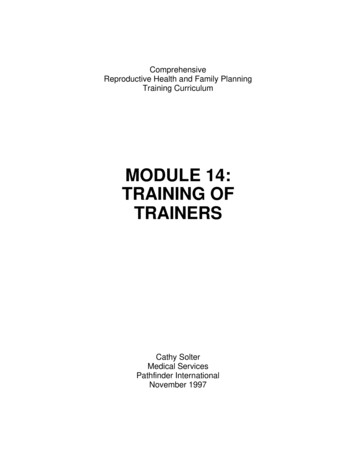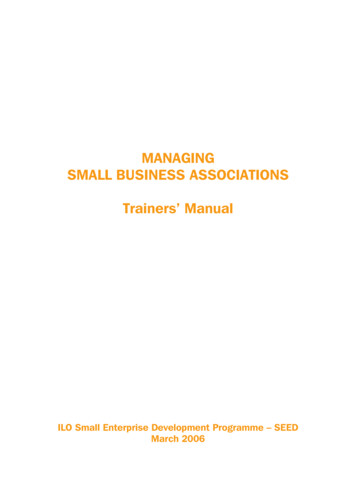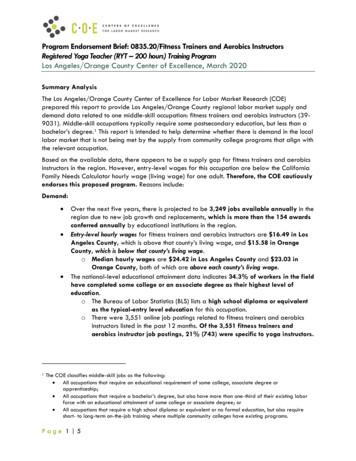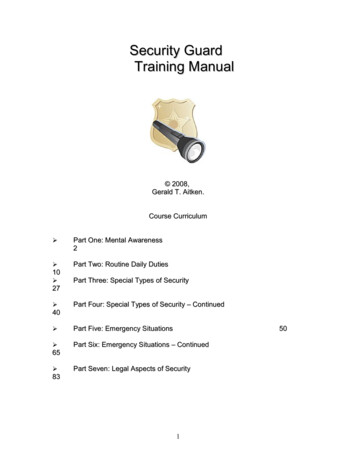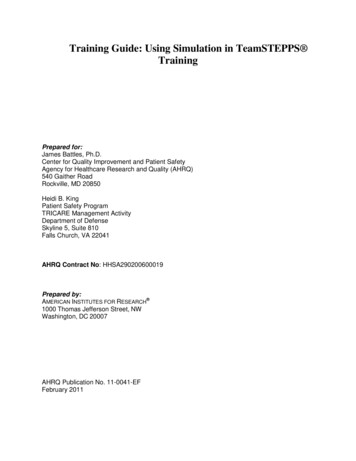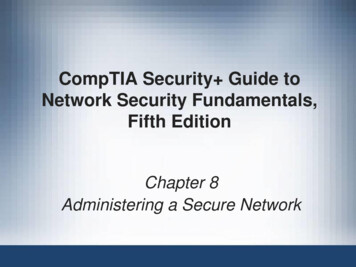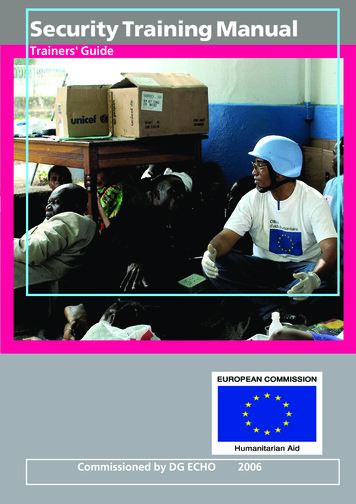
Transcription
DraftSecurity Training ManualTrainers' GuideSub headerCommissioned by DG ECHO2006
Trainers’ GuideDG ECHO Security Training ManualDG ECHO Security Training Manual: Trainers’ Guide by Emma Jowett 20060
DG ECHO Security Training Manual: Trainers’ Guide by Emma Jowett 20060
ContentsPage NumberSection One – Overview of the Modules3The module structureCore modules (1 – 6)Procedural modules (7 – 10)Response modules (11 – 15)Personal skills modules (16 – 17)Additional modules445677Section Two – About the Modules8The aim of the modulesHow to use the modulesModule contents888Section Three - Setting up Training11Deciding to trainAssessing the needChoosing which learning eventEstablishing roles and responsibilitiesThe lead trainerThe co-trainerThe managerBudgeting for trainingChoosing the venueSome rules for safety and security of trainingPromoting the Training Focus1111111212121212141414Section Four – Preparing to train15Preparing for the sessionSetting objectivesSMART objectivesIdentifying key learning pointsAdapting the modules1516161718Section Five – Training tips19Beginning the sessionIntroductionsThe middle of the sessionProcess issuesDocumenting outputs from trainingCreating space for participants tot exchange experience191920202020DG ECHO Security Training Manual: Trainers’ Guide by Emma Jowett 20061
Giving and receiving constructive feedbackTechniques for giving feedbackTechniques for receiving feedbackIce- breakers and energisersTips for using ice- breakers and energisersExamples of ice- breakers and energisersHints for training multi-lingual participantsIndividual workPairs workSmall group workConsiderations for small group workSplitting groupsTraining or content issuesSelecting training methodsTips for using role playTips for using case studiesTips for using brainstormsTips for leading discussionsTips for questions and elicitationTips for using PowerPointGiving instructionsDealing with challenging behaviourEnding the sessionReviewing learningEvaluating the trainingGroup evaluationsIndividual evaluationsFinally remember the following 3343536AppendicesAppendix 1: Suggested agendaAppendix 2a: Lead trainers responsibilities chartAppendix 2b: Co-trainers responsibilities chartAppendix 2c: Managers responsibilities chartAppendix 3a: Individual evaluation form (end of session)Appendix 3b: Individual evaluation form (end of training)Appendix 4: Certificate of attendanceAppendix 5: Checklist for organising a trainingAppendix 6: Checklist for the training venueAppendix 7: BibliographyAppendix 8: Glossary of termsDG ECHO Security Training Manual: Trainers’ Guide by Emma Jowett 200638394040414244454647482
Section One: Overview of the ModulesThe Module StructureThe security modules in the Security Training Manual are divided into four sections:Core Modules (1 – 6)Procedural Modules (7 – 10)Response Modules (11- 15)Personal Skills Modules (16 – 17)The following tables lay out the key content for each module in more detail. For details of theobjectives and key learning points for each module go to the module session plan in theSecurity Training Manual.Core ModulesThe core modules are appropriate for all staff, both national and international. The modulesdetail the basic concepts that link security with the organisation and the individual.In most cases the core modules should be run before the other modules as they providedefinitions and the foundation for understanding the rest of the modules.Although the modules are numbered the trainer may choose to run the modules in any order,depending on the needs of the agency and staff.Number and titleContentDefinitions of safety and securityModule 1:A SystematicApproach to SecurityModule 2:The importance of a systematic approach to securityThe link between good security systems and effective aidprogrammesThe role of staff in contributing to their own and otherssecurityThe link between security and the agency’s values andmissionThe Organisation, The The link between security and the agency’s programmeIndividual andThe importance of staff delivering a consistent message aboutSecuritytheir agency’s values and activitiesDG ECHO Security Training Manual: Trainers’ Guide by Emma Jowett 20063
Number and titleContentContextual factors can impact on security levelsModule 3:The Context andSecurityRelationships between actors is an essential factor to assessThe importance of gathering information from a variety ofsourcesThe need to constantly review and update information on thesituationDefining threat, risk and vulnerabilityModule 4:Identifying the relationship between the three termsAssessing RiskHow to carry out a personal risk assessmentAssessing the proportionate riskDifferent types of approaches to securityModule 5:Image and acceptance as an approachImage andAcceptanceHow different groups may perceive an agencyThe impact of individual behaviour on an acceptanceapproachThe International legal frameworkModule 6:Rights and responsibilities outlined in the legal frameworkRights andResponsibilitiesHumanitarian principles and codes of conductThe link between security and adhering to and respectinglegal standards and humanitarian principlesProcedural ModulesThe four procedural modules explore aspects of security that can be mitigated throughsensible security procedures.These modules aim to inform individual staff about security procedures, and explain theimportance of adhering to security procedures at all times. During the sessions participantsare encouraged to consider how individuals can contribute to the security of the whole teamby following the SOPs and ensuring others also do.Number and titleContentThe purpose of incident reportingModule 7:What constitutes an incident and why it is important to reportincidents and ‘near misses’Incident ReportingDifferent types of reports (internal and external)When to report, and what to include in a reportModule 8:Identifying threats to buildingsDG ECHO Security Training Manual: Trainers’ Guide by Emma Jowett 20064
Security of BuildingsProcedural and physical aspects of buildings securityThe role of an image and acceptance approach in choosingappropriate security measuresModule 9:Travel Safety andSecurityProcedures relating to choice of vehicle, vehicle safety andplanning journeysConvoy proceduresHow to behave at checkpointsRoad traffic accident proceduresAdvantages and disadvantagestelecommunications equipmentofdifferenttypesModule 10:Regulations and protocols relating to communicationCommunicationsSet up and maintenance of telecommunications equipmentofEffective use of different types of equipmentResponse ModulesEach of the five response modules outlines basic steps to follow in case of a securityincident occurring. Trainers should incorporate agency specific policies and procedures intoeach of the modules.Modules should be run on the basis of the likelihood of the threat occurring in the contextwhere the agency is working.Number and titleContentAssessing personal threats in a specific context andassessing individual vulnerabilityModule 11:CrimeIdentifying ways to reduce personal vulnerabilityOutline steps to take in case of theft, assault or sexualviolenceDefine support mechanisms available within the agencyModule 12:Ambush and car-jackingMinimise the risk of encountering a car jacking orambushSteps to follow in the event of a car-jacking or ambushPractise responding to different scenariosThe nature of threats from land mines, UXOs, IEDs andbooby trapsModule 13:Mines and otherExplosive DevicesExamine the level of risk in the contextSteps that should be taken to avoid landmines, UXO andbooby trapsHow to behave when encountering a landmine or UXOModule 14:Gunfire, Grenades andShellingThe nature of threats from gunfire, grenades or shellingHow to respond appropriatelyDG ECHO Security Training Manual: Trainers’ Guide by Emma Jowett 20065
Different causes for abduction and kidnappingModule 15:Abduction andKidnappingWays to reduce the risk of being kidnappedMeasures to improve the chances of survival during akidnappingOutline steps the agency will be taking to secure arelease.Personal Skills ModulesThe two personal behaviour modules deal with two aspects of personal behaviour, stressand aggression, that, when well managed, can lead to a reduction of risk for individuals andteams.These modules can be interspersed with modules from other sections.Different types of stress and symptoms of stressModule 16:Dealing with StressHow a lack of stress management can increaseindividuals’ and others’ security risksOrganisational support mechanisms for relieving stressIndividual coping strategies for dealing with stressModule 17:Dealing with AngerAdditional ModulesSecurity is a huge topic. These modules cover the basic aspects that are most commonlymet at a personal level. However trainers may need to develop additional modules forspecific issues such as, for example, fire fighting or bomb searches, if they are deemed to bea threat in the context.DG ECHO Security Training Manual: Trainers’ Guide by Emma Jowett 20066
Section Two: About the ModulesThe Aim of the ModulesThe aim of the DG ECHO Security Training Modules is to familiarise aid workers withessential concepts relating to security and provide a foundation for operating in insecureenvironments by exploring individual and agency responsibilities with regards to securityprocedures, policies and approaches.The modules provide those staff, entrusted with the role of security, some basic trainingmodules that can be used to train both national and international staff in the field.The modules are intended for use within an agency and should not be read as prescriptive.They provide a framework for training and aim to relieve trainers of reinventing wheels bygiving suggestions for training activities accompanied by notes on essential content.There is no specific order in which the modules should be run, although there are somesuggestions for agendas later in this section. The trainer should make these decisions basedon the needs of their audience, the context and the time they have available.N.B.: It is important that trainers still adapt the module session plans to suit their ownenvironment and to incorporate specific agency policies and procedures.How to use the ModulesThe modules are intended for adaptation to your own specific organisation or context. Themodules can be run over a period of weeks, for example, one session per week, or as a twoto three day training course. Each module is short in duration in recognition of the fact thateveryone is pressed for time!Firstly read the module content notes and session notes. Use the objectives of each moduleand the session notes to decide how to formulate your session. Consider the size of yourgroup and their learning needs as well as the resources available to you before completingthe session plan attached to each module.Module ContentsFollowing is a guide to the components in each module.Why does this session matter?This section provides the rationale for running the session by showing how the contentrelates to security. Guidance is given about the essential themes of the session, and links toother modules are made explicit.ObjectivesThese are the learning objectives that the trainer would expect each participant to achieveby the end of the module. There are three or four objectives per module and they are writtenin a way that a trainer could actually assess whether or not a participant has achieved themat the end of a session.The objectives are important as they indicate the essential skills, knowledge or attitude thatshould be trained in each session.DG ECHO Security Training Manual: Trainers’ Guide by Emma Jowett 20067
Key Learning PointsThe key learning points relate to the essential knowledge requirements in each module.They represent key content for every session and are arranged in a logical sequence fortraining.Session at a GlanceThe ‘session at a glance’ table provides a quick reference point and contains the essentialsession concepts, suggested training activities and estimated timings. These are notsuggestions only and can be adapted by the trainer as appropriate, depending on theaudience or context.ResourcesThe resource list for each session contains the specific resources that are needed for thatparticular module. That may include items such as handouts or specific training materialssuch as case studies or training activities.Those items, such as flip charts and pens, that are required for every session are listed inAppendix 6: Checklist for the training venue.ReferencesDocuments in this section represent recommendations for further reading besides thecontent notes.GuidanceThese notes represent training issues specific to the module. They should be read beforedelivering the session and may influence how a session is run.Content notesThese notes provide a précis of the essential content that is required for each module. Theyare linked to the session plan and intend to elaborate on the key learning points. It isrecommended that the trainer read the content notes before delivering the session.The content notes are mainly drawn from the DG ECHO Generic Security Guide. Someadditional texts are also represented such as the Safety First Handbook of Save theChildren, the GPR8 by K Van Brabant, the CARE Security Manual.Session notesThe session notes represent a recommended framework and sequence to help the trainerplan a session appropriate for their context. The session notes break the content intoconcepts and logical steps. Each step has a suggested training activity. The session notesalso provide tips on how to run the different activities and highlight when there arePowerPoint slides to accompany the material.It is important that trainers approach training with an attitude of ‘making it their own’. Theyshould use the session notes to plan a session that is suitable for their specific conte
DG ECHO Security Training Manual: Trainers’ Guide by Emma Jowett 2006 3 Section One: Overview of the Modules The Module Structure The security modules in the Security Training Manual are divided into four sections: Core Modules (1 – 6) Procedural Modules (7 – 10) Response Modules (11- 15) Personal Skills Modules (16 – 17)File Size: 1MBPage Count: 56

